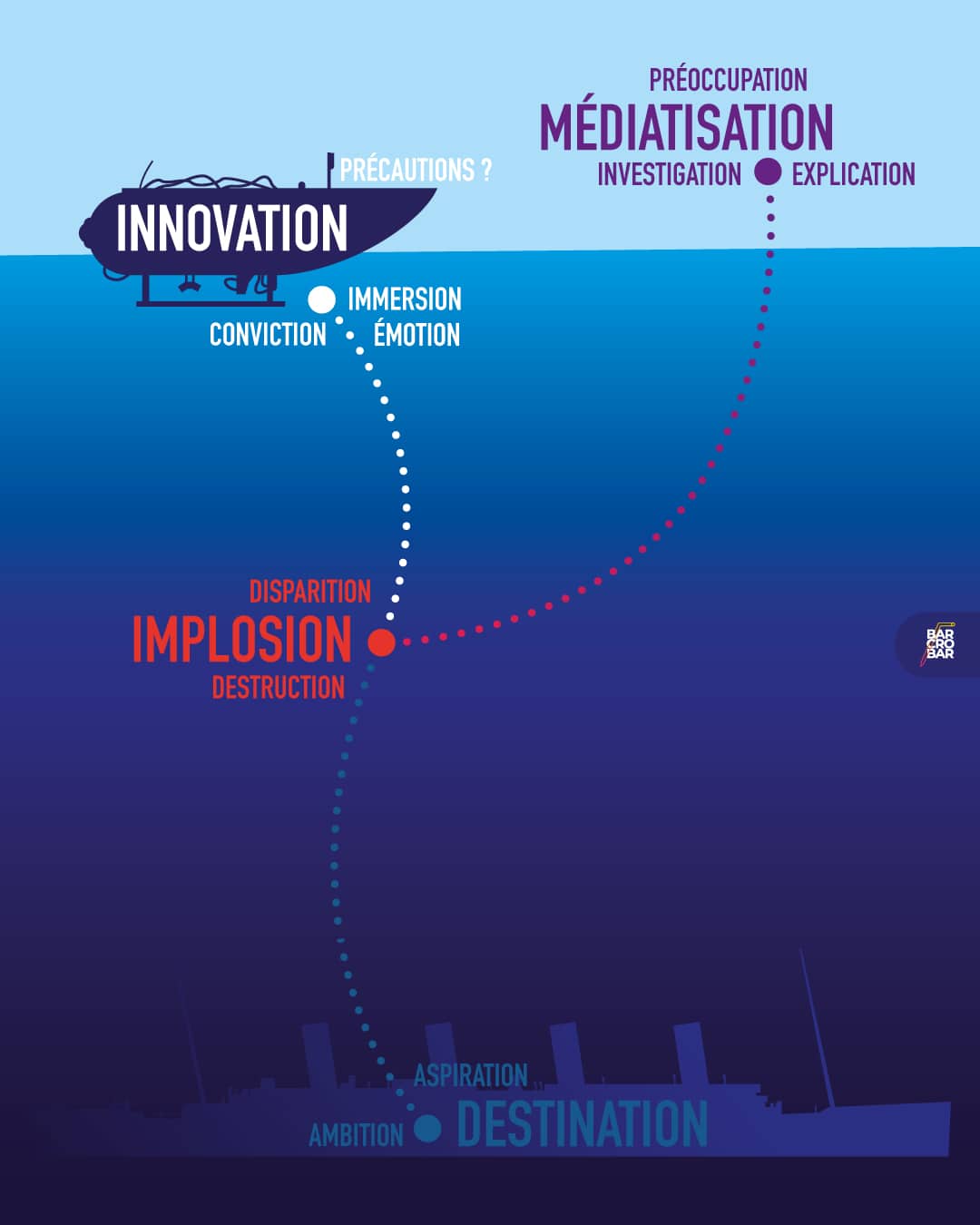In the autumn of 1911, a huge piece of ice broke off from a glacier to the south-west of Greenland's vast ice cap. Over the following months, it slowly drifted southwards, melting little by little as the sea currents and the wind blew it away.
Then, on the cold, moonless night of 14 April 1912, a 125-metre-long (410-foot) iceberg - all that remained of the 500-metre chunk of ice that had left a Greenland fjord the previous year - collided with the ocean liner RMS Titanic, which was making its maiden voyage from Southampton in the United Kingdom to New York in the United States. In less than three hours, the ship sank, taking more than 1,500 passengers and crew with her. The wreck now lies almost 3.8 km beneath the waves, almost 400 miles (640 km) south-east of the coast of Newfoundland.
Icebergs are always a hazard to shipping: in 2019, 1,515 icebergs drifted far enough south to enter the transatlantic shipping lanes between March and August. But Titanic's final resting place has its own dangers, which means that visits to the world's most famous wreck are a major challenge.
- What can we expect after the deaths of the Titan submarine crew?
- "It's a disaster. Everything has been washed away".
- What are these mysterious stones found in rock 2.8 billion years old?
After the disappearance of a five-person submersible that was carrying paying passengers on an excursion to the wreck of the Titanic, the BBC has turned its attention to this region of the ocean floor.
Navigating the depths
The depths of the ocean are dark. Sunlight is absorbed very quickly by the water and cannot penetrate more than 1,000 metres from the surface. Beyond that, the ocean is plunged into perpetual darkness. This is why the Titanic is in a region known as the "midnight zone".
Previous expeditions to the wreck site described a descent of more than two hours in total darkness before the ocean floor suddenly appeared under the lights of the submersible.
With line of sight limited beyond the few metres illuminated by the onboard lights of the truck-sized submersible, navigation at this depth is a real challenge, and it's easy to become disorientated on the seabed.
- 5 myths that persist about the Titanic more than a century after it sank
However, the detailed maps of the Titanic wreck site, produced by decades of high-resolution scanning, can provide landmarks when objects are visible. Sonar also allows the crew to detect features and objects beyond the small area of light illuminated by the submersible.
Submersible pilots also rely on a technique known as inertial navigation, which uses a system of accelerometers and gyroscopes to track their position and orientation relative to a known starting point and speed. OceanGate's Titan submersible is equipped with a state-of-the-art autonomous inertial navigation system, which it combines with an acoustic sensor called a Doppler Velocity Log to estimate the vehicle's depth and speed relative to the seabed.
Despite this, passengers on previous Titanic voyages with OceanGate have described how difficult it is to find your way around once you reach the bottom of the ocean. Mike Reiss, a TV comedy writer who worked on The Simpsons and took part in an OceanGate voyage on the Titanic last year, told the BBC: "When you hit the bottom, you don't know where you are. We had to wriggle blindly along the bottom of the ocean knowing the Titanic was somewhere, but it's so dark that the biggest thing under the ocean was only 500 metres away from us and we spent ninety minutes looking for it."
Crushing depths
The deeper an object sinks into the ocean, the greater the pressure of the water around it. On the seabed, at a depth of 3,800 m, the Titanic and everything around it was subjected to pressures of around 40 MPa, or 390 times higher than at the surface.
"To put that into perspective, it's about 200 times the pressure of a car tyre," Robert Blasiak, an oceanography researcher at Stockholm University's Stockholm Resilience Centre, told BBC Radio 4's Today programme, "That's why you need a submersible with very thick walls." The Titan submersible's carbon fibre and titanium walls are designed to enable it to operate at a maximum depth of 4,000 metres.
- Why is NASA exploring the depths of the Earth's oceans?
We are probably most familiar with the strong surface currents that can sweep boats and swimmers off their course, but there are also underwater currents deep in the ocean. Although they are generally not as powerful as those found at the surface, they can nonetheless move large quantities of water. They can be driven by surface winds that influence the water column below, by tides in deep waters or by differences in water density due to temperature and salinity, known as thermohaline currents. Rare events known as benthic storms - which are generally linked to eddies at the surface - can also cause powerful, sporadic currents that can carry material along the seabed.
The information we have on the underwater currents around the Titanic, which was divided into two main sections after the bow and stern separated during the sinking, comes from research into the shapes of the seabed and the movement of squid around the wreck.
Part of the wreck of the Titanic is known to lie close to a section of the seabed affected by a southward-flowing current of cold water known as the Western Boundary Undercurrent. The flow of this 'undercurrent' creates migratory dunes, ripples and ribbon-like patterns in the sediments and mud of the seafloor, which have enabled scientists to understand its force. Most of the formations observed on the seabed are associated with relatively weak or moderate currents.
The ripples of sand along the eastern edge of the Titanic's debris field - the scattering of personal effects, fittings, coal and parts of the ship itself that spilled out during the sinking - indicate the existence of an east-west undercurrent, while within the main wreck site, the scientists say, the currents tend from north-west to south-west, possibly due to the larger pieces of the wreck changing their direction.
To the south of the bow, the currents appear to be particularly changeable, flowing from north-east to north-west and south-west.
Many experts expect that the winnowing of these currents will eventually bury the wreck of the Titanic in the sediment.
Deep-sea marine archaeologist Gerhard Seiffert, who recently led an expedition to scan the wreck of the Titanic in high resolution, told the BBC that he did not think the currents in the area were strong enough to pose a risk to a submersible - provided it had electricity.
"I am not aware of any currents posing a threat to an operational deep-sea vehicle at the Titanic site," he said. "In the context of our mapping project, currents represented a challenge to the accuracy of the mapping, not a safety risk."
Sediment flows
After more than a hundred years at the bottom of the sea, the Titanic has gradually deteriorated. The initial impact of the two main sections of the ship colliding with the seabed twisted and deformed large parts of the wreck. Over time, microbes that feed on the ship's iron have formed icicle-shaped "hardnesses" and are accelerating the deterioration of the wreck. In fact, scientists estimate that the higher bacterial activity on the stern of the ship - largely due to the greater damage it has sustained - is causing it to deteriorate forty years faster than the bow.
The wreck is constantly collapsing, mainly due to corrosion," explains Mr Seiffert. Every year, a little bit. But as long as you stay at a safe distance - no direct contact, no penetration through openings - no damage is to be feared."
Although extremely unlikely, sudden flows of sediment at the bottom of the sea have already damaged and even washed away man-made objects on the ocean floor.
The most significant events - such as the one that severed the transatlantic cables off Newfoundland in 1929 - are triggered by seismic phenomena such as earthquakes. There is a growing awareness of the risk posed by these events, although there is no evidence that an event of this type was involved in the disappearance of the Titan submarine.
Over the years, researchers have identified signs that the seabed around the wreck of the Titanic was affected by huge submarine landslides in the distant past. Huge volumes of sediment appear to have slid down the continental slope from Newfoundland to create what scientists call an "instability corridor". They estimate that the last of these 'destructive' events occurred tens of thousands of years ago, creating layers of sediment up to 100 metres thick. But these events are extremely rare, explains David Piper, a marine geology researcher at the Geological Survey of Canada, who spent many years studying the seabed around the Titanic. He compares these events to the eruption of Vesuvius or Mount Fuji in terms of frequency - on the order of once every tens of thousands or hundreds of thousands of years.
Other phenomena known as turbidity currents - where water becomes loaded with sediment and flows along the continental slope - are more frequent and can be triggered by storms. "We show a repetition interval of around five hundred years," explains Piper. But the topography of the seabed in the area should direct the sediment flows towards a feature known as the 'Titanic Valley', which would mean that they would not reach the wreck at all.
According to Seiffert and Piper, it is unlikely that such an event could have played a role in the disappearance of the Titan submersible.
Other geological features around the wreck site have yet to be explored. During a previous expedition to the Titanic with OceanGate, Paul-Henry Nargeolet, a former French Navy diver and submersible pilot, visited a mysterious anomaly that he had detected with sonar in 1996. It turned out to be a rocky reef, covered in marine animals. He was hoping to visit another landmark that he had detected near the wreck of the Titanic on previous expeditions.
As the search continues for the missing ship, there are few clues as to what may have happened to the Titan and her crew. But in such a harsh and inhospitable environment, the risks involved in visiting the wreck of the Titanic are as relevant today as they were in 1986, when the first people to set eyes on the ship since it sank embarked on the journey to the depths.
Text by Richard Gray / BBC Future




